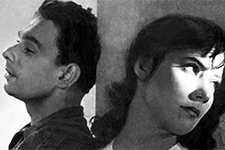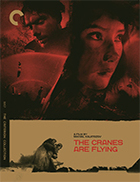The Cranes Are Flying (Letjat zhuravli)
|  The Cranes Are Flying (Letjat zhuravli) tells an old, melodramatic war story in visual terms that are so striking and evocative that you are able to overlook the plot ellipses, contrivances, and clichés and revel in the romantic impact. Winner of the Palm d’Or at the 1958 Cannes Film Festival, it marked the beginnings of the post-Stalinist cinema, when the first truly great Soviet films since the work of Eisenstein emerged after a decade of strict political repression at the hands of the bureaucratic commissar Anatoly Lunacharsky. Director Mikhail Kalatozov and cinematographer Sergei Urusevsky (in the first of their four collaborations, the last of which was 1964’s I Am Cuba, an avant-garde celebration of Cuba’s communist revolution) bring to The Cranes Are Flying an immediate visual style that beautifully incorporates highly evocative stylistic devices particularly reminiscent of the silent era. Canted angles, extreme close-ups, and a mix of hectic hand-held camerawork and carefully composed long shots help reinforce the film’s dramatic urges, visualizing emotions in ways that only the cinema can do. There are several montage sequences that would have impressed Eisenstein, particularly a scene in which a young soldier is shot, and Kalatozov extends the moment of his death into a swirling visualization of his last thoughts, match-cutting spinning trees above with his memories of a desperate race up a flight of stairs and images of a wedding that will never take place. Kalatozov’s career as a filmmaker began in the silent era and stretched all the way into the late 1960s, but his dazzling artistry put him on the wrong side of the censors early in his career. His 1931 film The Nail in the Boot (Lursmani cheqmashi) was banned for committing the “ideological error” of emphasizing formalism at the expense of Josef Stalin’s ordained socialist realism (liner notes for a recent MoMA screening of the film list the specific sins: “its oblique narrative, visual abstraction, and sympathetic portrayal of a soldier who inadvertently commits sabotage through his ineptitude on the battlefield”). The “thaw,” as it came to be known, in the late 1950s following the death of Stalin once again allowed Kalatozov and other artists to explore and experiment with visuals, narrative, and an influence on the individual that had been impossible within the dogmatic party discipline under Stalin. Not surprisingly, the late 1950s and ’60s were a golden era for Kalatozov, in which he produced a series of films, beginning with The Cranes Are Flying, that garnered international acclaim at various film festivals and played in western countries via exchange programs. The story, written by dramatist Viktor Rosov from his 1943 play Life Eternal, begins in highly—almost self-consciously comical—melodramatic form as we are introduced to two young lovers, carefree Veronika (Tatyana Samojlova) and devoted factory worker Boris (Aleksei Batalov). Alas, their romantic idyll is forever interrupted by World War II (the film begins on June 22, 1941, the day the Germans invaded the Soviet Union). Boris, being the upright, conscientious young man that he is, doesn’t wait to be drafted, but rather volunteers for military service, while his cousin, Mark (Aleksandr Shvorin), who has his eye on Veronika, gets an exemption due to his musical talents. The narrative then splits between Veronika’s experiences on the home front and Boris’s on the front lines. Both are filled with violence and tumult (unlike American war films, in which the home front is a place of physical safety), as Veronika endures never-ending German air raids that reduce entire city blocks to rubble and Boris slogs through the mud and blood of the battlefield. The focus of the narrative, however, is primarily on Veronika and her eventual decision to not wait for Boris and to marry Mark instead. Unfortunately, this particular narrative development is hard to swallow, especially because Veronika never had and never does show any affection for Mark whatsoever. There is on over-the-top scene in which Mark confesses his love for Veronika in the midst of a massive air raid, with Verokina’s repeatedly slapping his face and screaming “Nyet!” rhythmically syncopated with the dropping of the bombs. That she would turn around in the very next scene and marry him is a bit hard to swallow. But, such is melodrama, and the film redeems itself through the continually brilliant use of striking visuals to evoke Veronika’s growing sense of guilt about her decision. Tatyana Samojlova, a young stage actress in her first leading screen role, has a fresh face and expressive eyes; she is wonderful in the role, and she sustains the pressures of repeated extreme close-ups very well. There is one scene in particular in which Boris’s father (Vasili Merkuryev), a doctor, berates a wounded soldier for pitying himself because his girlfriend left him for someone else, declaring that such a woman is to be condemned and isn’t worth his tears. The harshness of the speech has an obvious double edge, as it could have just as easily been directed at Veronika herself, and the anguish and distress she feels registers with sharp clarity on Samojlova’s face. Unlike some of Kalatozov’s other films (including the almost-lost I Am Cuba), The Cranes Are Flying was a great international success, premiering in the United States in 1960 as part of the cultural exchange program between the Soviet Union and the U.S. State Department (Bosley Crowther gushed over it in the pages of The New York Times). Interestingly, it was not well received in the Soviet Union by critics until after it was celebrated throughout Europe and won the Palm d’Or. It is easy to see why the film would be so popular—its poignant melodrama and focus on human emotions appealed to moviegoers, particularly those fond of the emotional histrionics of Douglas Sirk or Vincent Minnelli, while its impressive visual style, mixing stark realism with moments of near surrealism, enthralled critics. The Cranes Are Flying also likely appealed across national boundaries because it was a daring film for its time, breaking with the rigorous (and artistically deadening) Soviet tradition of socialist realism and patriotic war films that celebrated unconditionally the sacrifice of soldiers for Mother Russia. Kalatozov’s film is not so simple, and the most indelible theme to emerge at the end is the horrors of war and how it should be avoided at all costs (this is delivered in strong fashion in a speech by Boris’s brother, Stepan). Again, this is strengthened by the film's visual power, particularly the stunning tracking shots of Boris and the other soldiers in the field. Kalatozov manages to evoke a world of chaos with smoke, sound effects, and very few extras. Yet, the overall impact is one of great magnitude, as The Cranes Are Flying shifts away from the comforting political rhetoric of the necessity of war and instead focuses on its greatest cost: the human one.
Copyright © 2020 James Kendrick Thoughts? E-mail James Kendrick All images copyright © The Criterion Collection | |||||||||||||||||||||||||||||||
Overall Rating: 


 (3.5)
(3.5)


